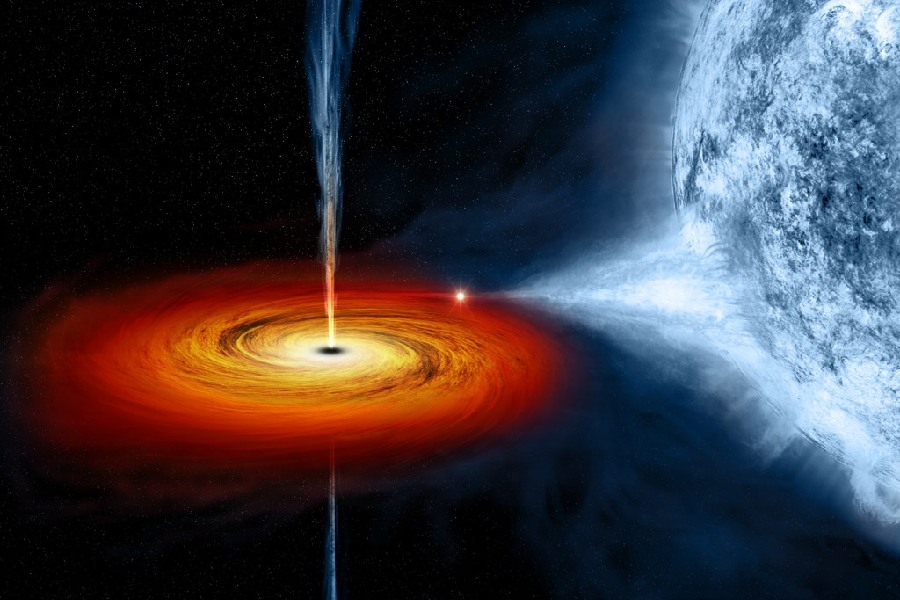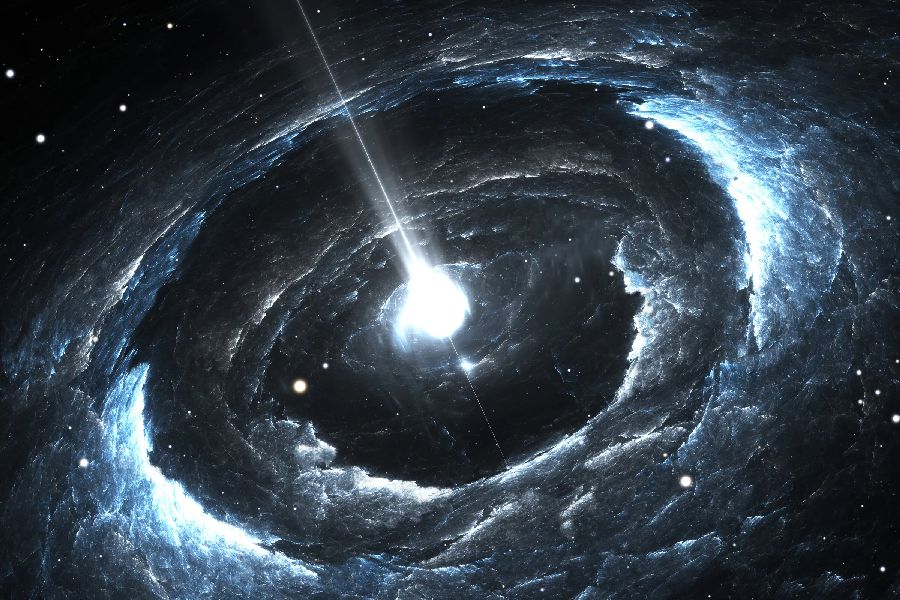Pulsars are some of the most extraordinary objects in our universe. These bizarre cosmic sources emit beams of electromagnetic radiation, usually in radio wavelengths or X-rays, in an unbelievably precise and consistent manner. But what exactly causes these precisely timed pulses seen across the cosmos? What is a pulsar, after all?
This article provides a deep exploration of these mysterious objects. We’ll cover how pulsars were first discovered, what are the key characteristics that define them, and the different types observed. Additionally, we’ll explore enduring mysteries about these cataclysmic products of stellar evolution.
Join us on an exploration of some of the most unusual inhabitants of our galaxy!

What Is a Pulsar?
What is a pulsar? A pulsar is like a cosmic lighthouse in space. It’s a type of rotating neutron star, which is incredibly dense and formed from the remnants of a massive star’s explosion. As the pulsar spins, it emits beams of radiation from its magnetic poles.
These beams sweep across space like a beacon, and when they point toward Earth, we detect them as regular pulses of light. Pulsars are known for their precise timing, often pulsing hundreds of times per second.
Discovery of Pulsars
In 1967, researchers Jocelyn Bell Burnell and Antony Hewish made an important discovery that launched the field of pulsar astronomy. While studying space, they detected something unexpected. Highly precise radio pulses repeat every 1.33 seconds from an unknown source.
Bell Burnell named the baffling discovery LGM-1, meaning “Little Green Men”, referring to the regular pulses. As a diligent graduate student, Bell Burnell carefully analyzed data charts and noticed the strange new signal that others had missed.
Her supervisor, Hewish, provided guidance and constructed the radio telescope used in the analysis. He recognized the significance of the discovery. In 1969, they identified the first pulsar, CP 1919, located in the Vulpecula constellation. This allowed them to connect pulsars to rapidly spinning neutron stars with extreme density.
Many feel Bell Burnell should have shared the 1974 Nobel Prize awarded only to Hewish for this revelatory finding. The discovery of CP 1919 marked a major milestone that opened up the new field of pulsar astronomy.
Formation of Pulsars
How is a Pulsar formed? Pulsars form from the remnants of massive stars that have gone supernova. When stars over 8-10 solar masses explode in supernovas, their cores rapidly collapse into incredibly dense neutron stars about 12 miles wide. During this collapse, angular momentum is conserved.
A smaller neutron star spins extremely fast, often hundreds of times per second. It is this rapid rotation combined with the intense magnetic field of the neutron star remnant that allows pulsars to emit their focused radio beams.
So, while not all supernovas create pulsars, pulsars require the initial supernova explosion and resulting neutron star in order to form. The high spin rate of the dense remnant is the key to pulsar creation.
The formation process starts with the cataclysmic death of a massive star. Then, the spinning neutron star remnant produces the beamed emission signatures unique to pulsars. This multi-step process connects the life cycles of massive stars to the birth of unusual objects like pulsars across our galaxy.
Characteristics of Pulsars
Key characteristics of pulsars
Pulsars have some special characteristics that make them stand out. First, they spin very rapidly and have extremely powerful magnetic fields. These traits allow them to send out focused bursts of radiation. The radiation sweeps past Earth in beams, creating observed pulses – which is the origin of the name “pulsar”.
The two defining pulsar qualities are fast rotation speed and strong magnetism. Their rapid spin and focused radiation beams arise from their powerful magnetic fields. The combination of spin and magnetism is what produces the pulsar effect.
Magnetic fields, rotation, and radiation
Pulsars can spin at incredible speeds – up to hundreds of times per second. This rapid rotation originates from the angular momentum of the collapsed stellar core that forms the pulsar. This is why pulsars only result from supernovae. A pulsar’s magnetic field is trillions of times more powerful than Earth’s field.
This extreme magnetism is created by the compressed matter of the neutron star. It focuses the pulsar’s beams of radiation. As a pulsar rotates, its magnetic field directs focused radiation beams along the magnetic poles. This creates sweeping emissions that are highly focused. We detect the radiation as periodic pulses when the beams sweep past Earth repeatedly.

Pulsar Emission
Pulsars emit periodic beams of radiation due to their rapid rotation and strong magnetic fields. The powerful magnetic field focuses charged particles along the magnetic axes, creating focused beams of emission.
These tightly collimated beams sweep around like lighthouse beacons as the pulsar spins hundreds of times per second. When the rotating beams repeatedly cross our line of sight. We observe pulses of radiation at regular intervals matching the pulsar’s spin period.
The combined fast rotation and strong magnetism produce the sweeping beams that give rise to the pulsing emission that defines pulsars. The lighthouse-like sweeping beams of a pulsar are unique to these stellar remnants.
As they spin, the beams cut across space and across Earth, appearing from our vantage point as precise flashes of light. The periodic pulses act as a clock driven by the unfailing rotation of the energetic neutron star.
Types of Pulsars
There are a few main kinds of pulsars. They are grouped by what wavelength of light they pulse in. Some pulse in radio, others in X-rays or gamma rays. Millisecond pulsars pulse very fast. While they pulse in different parts of the spectrum, all pulsars share common properties.
Their pulses come from the same processes. Just the details differ between types. Pulsars give us windows into extreme physics through their varied emissions. Studying all types widens our understanding of these unusual objects.
Radio pulsars and X-ray pulsars
Radio pulsars emit focused radio beams as they spin. Radio telescopes detect the pulses from Earth, where about 2000 radio pulsars have been found so far. The first pulsars detected were at radio wavelengths.
Radio pulsars remain the most frequently observed type in surveys, as their radio beams penetrate dust more easily. Analyzing radio pulse patterns constrains the neutron star environment. Radio waves provide a key window into pulsar emission mechanisms. These pulsars also give off intense beams of X-rays.
About 60 X-ray pulsars are known, often in binary systems. The X-rays come from gas falling onto the pulsar, shining light on extreme physics near neutron stars. Though less common than radio pulsars, X-ray pulsars also offer insights through their extreme emission processes.
Gamma-ray pulsars and millisecond pulsars
Over 70 gamma-ray pulsars are known. Their beams contain the highest energy photons. Orbiting gamma-ray telescopes discovered that they pulse in high-energy light, which ground telescopes cannot detect well.
Gamma rays indicate the acceleration of charged particles to astronomical energies, probing the exotic physics within pulsars. These gamma-ray pulsars spin hundreds of times a second at speeds faster than typical pulsars. They also orbit compact stellar companions.
Their very rapid, precise pulsations rival atomic clock stability, making them useful tools for timing studies. Accreting matter from a companion likely spins up the pulsar to these faster rotational speeds. Studying these recycled pulsars offers insights into their strange properties and origins.
Conclusion
We hope this exploration has shed light on the nature of these fascinating cosmic objects known as pulsars. Formed during the deaths of massive stars, pulsars rotate at incredible speeds, emitting focused beams of radiation that sweep across the universe.
Their clockwork-like pulses are a window into unique physics and extreme stellar environments. With densities beyond comprehension and magnetic fields stronger than imaginable. Pulsars push the boundaries of what we know about matter and magnetism.
This article dives into their mysterious origins, strange properties, and precise signals, thus uncovering what is a pulsar. We understand how a pulsar marks the remains of exploded stars. As research continues, pulsars promise more discoveries that enrich our understanding of the physics governing our remarkable universe.
